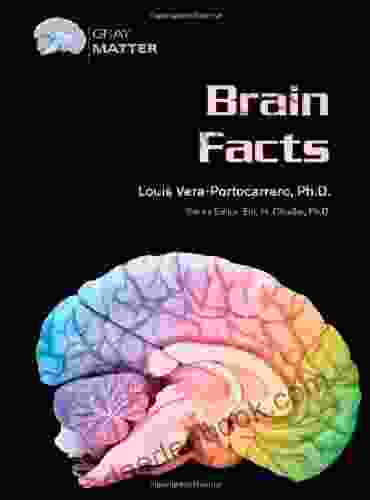Brain Facts: Gray Matter by Michael Sheridan

The human brain is a complex and fascinating organ, and scientists are still learning about its many functions. One of the most important parts of the brain is the gray matter, which is responsible for a wide range of cognitive functions, including memory, learning, and perception.
In this article, we will explore the gray matter of the brain, its functions, composition, and role in various neurological processes. We will also discuss some of the latest scientific findings and research on this fascinating aspect of the human brain.
Gray matter is one of the two main types of tissue that make up the brain, the other being white matter. Gray matter is found in the outer layer of the brain, as well as in some deeper structures. It is composed of nerve cell bodies, dendrites, and unmyelinated axons.
5 out of 5
| Language | : | English |
| File size | : | 2392 KB |
| Text-to-Speech | : | Enabled |
| Screen Reader | : | Supported |
| Word Wise | : | Enabled |
| Print length | : | 106 pages |
Nerve cell bodies are the main part of the neuron, and they contain the nucleus and other organelles. Dendrites are the branches of the neuron that receive signals from other neurons. Axons are the branches of the neuron that transmit signals to other neurons.
Myelin is a fatty substance that insulates axons and helps to speed up the transmission of signals. White matter is composed of myelinated axons, and it is found in the deeper structures of the brain.
Gray matter is responsible for a wide range of cognitive functions, including:
- Memory: Gray matter is essential for the formation and storage of memories. The hippocampus, which is a gray matter structure located in the medial temporal lobe, is particularly important for memory.
- Learning: Gray matter is also involved in learning. When we learn new information, new connections are formed between neurons in the gray matter.
- Perception: Gray matter is responsible for processing sensory information from the environment. The primary sensory areas of the brain, such as the visual cortex and the auditory cortex, are located in the gray matter.
- Consciousness: Gray matter is also thought to play a role in consciousness. The cerebral cortex, which is the outermost layer of the brain, is composed of gray matter. The cerebral cortex is responsible for higher-order cognitive functions, such as language, reasoning, and problem-solving.
Gray matter is composed of a variety of cell types, including neurons, glia, and blood vessels.
- Neurons: Neurons are the main cells of the gray matter. They are responsible for transmitting signals between different parts of the brain.
- Glia: Glia are cells that support neurons. They provide nutrients to neurons, remove waste products, and help to insulate axons.
- Blood vessels: Blood vessels supply the gray matter with oxygen and nutrients.
Gray matter plays a role in a variety of neurological processes, including:
- Synaptic plasticity: Synaptic plasticity is the ability of synapses to change their strength over time. This process is essential for learning and memory.
- Neurogenesis: Neurogenesis is the birth of new neurons. This process occurs in the hippocampus and other parts of the gray matter.
- Neurodegeneration: Neurodegeneration is the death of neurons. This process can occur in a variety of neurological disorders, such as Alzheimer's disease and Parkinson's disease.
Scientists are still learning about the many functions of gray matter. Some of the latest scientific findings and research on gray matter include:
- Gray matter volume: Studies have shown that the volume of gray matter in certain brain regions is associated with cognitive function. For example, a larger volume of gray matter in the hippocampus is associated with better memory.
- Gray matter connectivity: Studies have also shown that the connectivity between different gray matter regions is associated with cognitive function. For example, stronger connectivity between the hippocampus and the prefrontal cortex is associated with better memory and learning.
- Gray matter plasticity: Gray matter is a plastic tissue, meaning that it can change its structure and function over time. This plasticity is essential for learning and memory.
- Gray matter and neurological disorders: Studies have shown that gray matter abnormalities are associated with a variety of neurological disorders, such as Alzheimer's disease, Parkinson's disease, and schizophrenia.
The gray matter of the brain is a complex and fascinating structure that plays a vital role in a wide range of cognitive functions. Scientists are still learning about the many functions of gray matter, and their research is helping us to better understand the human brain and its many mysteries.
5 out of 5
| Language | : | English |
| File size | : | 2392 KB |
| Text-to-Speech | : | Enabled |
| Screen Reader | : | Supported |
| Word Wise | : | Enabled |
| Print length | : | 106 pages |
Do you want to contribute by writing guest posts on this blog?
Please contact us and send us a resume of previous articles that you have written.
 Book
Book Novel
Novel Chapter
Chapter Reader
Reader Library
Library Magazine
Magazine Newspaper
Newspaper Paragraph
Paragraph Sentence
Sentence Bookmark
Bookmark Shelf
Shelf Bibliography
Bibliography Foreword
Foreword Synopsis
Synopsis Footnote
Footnote Tome
Tome Bestseller
Bestseller Narrative
Narrative Autobiography
Autobiography Memoir
Memoir Reference
Reference Encyclopedia
Encyclopedia Dictionary
Dictionary Thesaurus
Thesaurus Narrator
Narrator Librarian
Librarian Catalog
Catalog Card Catalog
Card Catalog Borrowing
Borrowing Stacks
Stacks Study
Study Lending
Lending Academic
Academic Journals
Journals Rare Books
Rare Books Special Collections
Special Collections Literacy
Literacy Study Group
Study Group Awards
Awards Theory
Theory Richard Lawry
Richard Lawry Bright Summaries
Bright Summaries Arnab Biswas
Arnab Biswas Helen Lester
Helen Lester Madhavi Nawana Parker
Madhavi Nawana Parker Billie Letts
Billie Letts Imogen Paige
Imogen Paige India Knight
India Knight Immanuel Ness
Immanuel Ness Lori Holmes
Lori Holmes John Ralston Saul
John Ralston Saul Christopher Ward
Christopher Ward Michael Tanner
Michael Tanner Caimh Mcdonnell
Caimh Mcdonnell Charles Christopher Camosy
Charles Christopher Camosy Jesper Kaae
Jesper Kaae Jammie Jaye
Jammie Jaye Jeff Gross
Jeff Gross Ciannon Smart
Ciannon Smart Anna Hrachovec
Anna Hrachovec
Light bulbAdvertise smarter! Our strategic ad space ensures maximum exposure. Reserve your spot today!
 Fred FosterFollow ·12.9k
Fred FosterFollow ·12.9k Deacon BellFollow ·16.8k
Deacon BellFollow ·16.8k Juan RulfoFollow ·6.1k
Juan RulfoFollow ·6.1k VoltaireFollow ·10.2k
VoltaireFollow ·10.2k Jermaine PowellFollow ·5.3k
Jermaine PowellFollow ·5.3k Anthony WellsFollow ·14.4k
Anthony WellsFollow ·14.4k Stan WardFollow ·16.5k
Stan WardFollow ·16.5k Jamie BlairFollow ·9.8k
Jamie BlairFollow ·9.8k

 Amir Simmons
Amir SimmonsMore Zeal Than Discretion: A Closer Look at the Risks and...
Enthusiasm is often seen as a positive...

 Wayne Carter
Wayne CarterYear of the Dog: American Poets Continuum 178
Year of the Dog is a...

 David Foster Wallace
David Foster WallaceThe Constitution of the State of New York: A...
The Constitution of the...

 Harvey Bell
Harvey BellSmall Cetaceans of Japan: Exploitation and Biology
Small cetaceans, including...

 Blake Bell
Blake BellEffortless Elegance: A Comprehensive Guide to Captivating...
In the realm of crocheting,...
5 out of 5
| Language | : | English |
| File size | : | 2392 KB |
| Text-to-Speech | : | Enabled |
| Screen Reader | : | Supported |
| Word Wise | : | Enabled |
| Print length | : | 106 pages |














